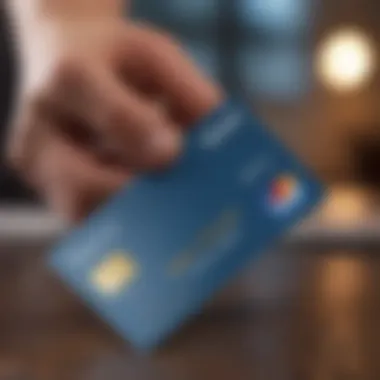Transfer Money from PayPal to Bank: A Complete Guide


Intro
In today’s digital age, where convenience rules the roost, transferring money between platforms has become as common as breathing. PayPal, one of the leading online payment systems, offers a seamless way for individuals and businesses to send and receive funds. But what happens when you need to take the money from PayPal and transfer it to your bank account? Whether you are a freelancer looking to cash out your earnings or a business wanting to manage your funds effectively, understanding this transfer process is crucial.
Many folks, especially financial enthusiasts and individual investors, often find themselves searching for detailed guidance on this topic. Not just how the process works but also what the implications are in terms of fees, processing times, and even security concerns. And that is precisely what this article aims to unravel.
As we dive deeper, you'll uncover valuable insights to empower your financial transactions between PayPal and your bank account. Through this guide, you will not only grasp the intricate process but also learn about best practices to maximize the benefits while minimizing potential obstacles. So, let’s get started!
Overview of PayPal to Bank Transfers
Understanding how to transfer money from PayPal to a bank account is essential for a multitude of reasons. First and foremost, it opens the gate for easier management of your finances. Whether you're a freelancer getting paid for services or just receiving money from friends or family, being able to convert your digital PayPal balance into usable cash is key.
Understanding PayPal
PayPal has woven itself into the fabric of online transactions. It’s not just a wallet; it's a platform that allows users to send and receive money safely and securely, all while keeping personal and financial information safeguarded. The beauty of PayPal lies in its convenience—it’s widely accepted by various merchants and even integrates effortlessly into e-commerce platforms. Users can send money with a few clicks, making it a favorite for quick transactions.
"PayPal is like a digital bank, minus the bricks and mortar."
The simple interface attracts both tech-savvy individuals and those who are a tad more cautious about online transactions. Unlike other financial services, it requires minimal setup and almost anyone can jump on board with just an email address.
Furthermore, PayPal supports multiple currencies, enabling users to transact internationally without the headaches that traditional banking systems might impose. This global reach adds a layer of robustness to its service offerings, making it clear why many users prefer it for online payments.
Importance of Linking to a Bank Account
Linking a bank account to your PayPal profile isn't merely a suggestion, it's a necessity if you plan to utilize the platform effectively. It paves the way for an uninterrupted flow of money between your digital wallet and traditional banking system.
The benefits of linking your bank account to PayPal are far-reaching:
- Easier Transfers: By connecting your bank account, you can transfer funds from PayPal directly into your bank account without a hitch, often in just a few clicks.
- More Control: You can easily pay for purchases directly from your bank account using your PayPal, which often helps in maintaining better management of your finances.
- Access to funds: When you link a bank account, you’ll have the ability to withdraw large sums, allowing you to efficiently utilize your PayPal balance.
Additionally, having a bank account linked gives you access to features like direct deposits and overdraft protection, optimizing your financial operations. Thus, linking your PayPal account with a bank isn’t just about convenience; it’s about creating a cohesive money management system that benefits your financial health.
Setting Up for Transfers
Setting up for transferring money from PayPal to a bank account is not just a matter of technical steps. It lays the groundwork for a smooth and hassle-free experience in the financial world. Having this setup done right makes all the difference as it streamlines your capability to manage funds effectively. Without taking the time to establish these key elements, you might find yourself in a pickle down the road, whether that’s dealing with delays or complications that spring up unexpectedly.
It's not just about the mechanics of transferring money. It’s about creating a secure and reliable base to work from. With a properly configured PayPal account and linked bank account, you can access funds quickly and without a lot of fuss. This section will take you through the essential steps to get everything in place.
Creating a PayPal Account
If you haven’t taken the plunge yet, creating a PayPal account is an essential first step in this process. It’s relatively straightforward; all you need to do is go to the PayPal website, choose to sign up, and fill in the necessary personal information. You’ll need to have a valid email address, as well as a strong password for security.
Once your account is set up, you'll have access to various features, from sending money to making purchases online. PayPal serves as a bridge between you and numerous online platforms, which makes it particularly useful for individual investors and financial enthusiasts alike.
Having a PayPal account also gives you valuable insights into your spending and receiving patterns. It allows you the flexibility to manage your finances with ease.
Linking a Bank Account
Linking a bank account to your PayPal is where the rubber meets the road. This connection is important as it influences how soon you can access your funds. When setting up this connection, you’ll be prompted to provide details from your bank, such as the bank name, account number, and routing number. Once linked, this bank serves as the funnel for all transfers.
Document Requirements
When linking your bank account, you'll encounter specific documentation requirements. These usually include providing personal identification, such as a driver’s license or passport, to confirm your identity and ensure that you’re who you say you are. These requirements serve as a protective measure against fraud and misuse. The nice part about this is that it adds a layer of security, benefiting you more than any hassle it might cause. You’ll also need to confirm that the information you supply matches what your bank has on file.
This careful process is a smart choice when handling finances. It ensures that only authorized users have access to the linked accounts, which can safeguard your funds from potential threats. The unique feature of this requirement is that it can weed out errors before they propagate into larger issues, such as transfer failures down the line.
Verification Process


The verification process of your linked bank account is another layer of security that's crucial. Once you submit your bank information, PayPal typically makes two small deposits into your bank account, usually within a few days. This step acts as a check to confirm ownership of the bank account you're trying to link.
The verification process is beneficial as it not only reinforces security but also enhances your peace of mind. Once your bank account is verified, you can utilize functions like transferring funds without unnecessary delays. It's a vital stage that mitigates issues related to mismatches or erroneous links that could prove troublesome later on.
However, this does come with its quirks. Sometimes, users report delays in those small deposits, which can hold up the process longer than expected. But rest assured, once completed, you'll find everything to be seamless moving forward.
With all these building blocks in place, you're ready for the next step in transferring money from PayPal to your bank account.
Steps to Transfer Money from PayPal to Bank
Transferring money from your PayPal account to your bank is a pretty essential skill in today's digital world. Knowing the right steps can save you time and prevent potential headaches. Whether you’re a casual user sending cash to a friend or a business owner needing to access funds quickly, understanding these steps is crucial. This ensures you not only make the transfer efficiently but also avoid common pitfalls. It’s like knowing how to swim before jumping into a pool—you want to be prepared.
Initiating the Transfer
The first thing you need to do is initiate the transfer. This step is your gateway to moving your money where you need it. Open your PayPal account, either through the app or website, and navigate to the transfer section. Here, you typically find an option labeled "Transfer to Bank" or something akin to that.
Important: Ensure that you are comfortable with your current PayPal balance. If you've made recent transactions or purchases, double-check how much money you actually can transfer.
Choosing the Transfer Amount and Method
Choosing how much to transfer and which method to use is a pivotal part of the process. Here’s what you need to know:
Standard Transfers
Standard Transfers are the bread and butter of moving money. Generally, these take 1 to 3 business days to complete, depending on your bank's processing times. What makes them a popular choice is that they often have lower fees—if any—compared to other types of transfers.
A key characteristic of Standard Transfers is that they’re quite reliable and simple. While they may lack the immediate gratification of faster methods, they usually come with fewer frills. If you don't need the cash right away, this is a solid option.
Advantages of Standard Transfers:
- Cost-effective: Often cheaper than other methods.
- Reliability: Generally stable with predictable timing.
Disadvantages:
- Slower compared to instant transfers, which may not suit urgent needs.
Instant Transfers
Instant Transfers, on the other hand, are the express lane for getting your money into your bank account ASAP. If time is of the essence, this option lets you move funds directly without delays, usually completed in mere minutes.
Why would someone choose Instant Transfers? A lot of folks like the confidence of having funds available right away when they have an unexpected bill or need to make a purchase.
Advantages of Instant Transfers:
- Speed: Funds are often available in minutes.
- Convenience: Handy for urgent needs.
Disadvantages:
- Cost: Typically involves higher fees, so it’s not ideal for larger sums or frequent transactions.
Reviewing Transfer Details
Once you’ve selected the amount and method, take a moment to review all finalized details. This is where you catch mistakes or miscalculations before they happen. Pay attention to the fees applied and the expected delivery time. Make sure everything aligns with your financial needs.
A thorough review can save you from unnecessary surprises that can cost you.
Confirming the Transfer
Finally, it's time to hit that confirm button. You'll often see a summary screen showing you the transfer details. After confirming, you're essentially placing your trust in the transfer timing that you’ve chosen—be it the older Standard Transfer or the swift Instant Transfer. This is the moment you let it ride and observe how well PayPal performs its end of the deal.


In summary, going through these steps carefully ensures that your transfers are smooth sailing. You’ve learned how to initiate, choose your amounts and methods, review your details, and confirm your transaction—all fundamental parts of the process that will help you navigate the world of PayPal effortlessly.
Processing Times and Fees
Understanding the dynamics of processing times and fees when transferring money from PayPal to a bank account is crucial. Often overlooked, these elements have a direct impact on how efficiently you can access your funds. Knowing the associated costs and timelines allows for better planning and can save you from unexpected hassles during your transactions. It’s not just about getting your money; it’s also about knowing how much you’ll give up in fees and how soon you can have access to that money.
Understanding Fees Associated with Transfers
When it comes to transferring money out of PayPal, fees can be a real kicker, and they vary based on methods and speeds of transfer.
- Standard Transfers are usually free, but they can take a few business days to hit your bank account. The kicker here is that while there are no fees associated, you might be left waiting longer than you’d like.
- Instant Transfers, on the other hand, come with a fee. PayPal typically charges a percentage of the transfer amount, and just like that, your withdrawal can start costing you a small chunk of change. It's advisable to consider these rates before you decide on the method, especially if you’re pulling out larger amounts.
- Currency Conversion Fees are another thing to watch out for if you’re sending money internationally. If the currency conversion comes into play, you'll be looking at additional costs that can make a dent in your expected total.
It’s wise to get familiar with all the fees you might encounter to make informed decisions during money transfers. This practice not only helps you maintain your financial health but also allows you to maximize your funds effectively.
Typical Processing Times for Transfers
Processing times can feel like a rollercoaster, and knowing what to expect can help minimize frustration:
- Standard Transfers: These usually take around 1 to 3 business days to process. While free, they might leave you twiddling your thumbs if you need the money sooner. In some cases, it can run longer, especially if your bank plays hard to get.
- Instant Transfers: As the name suggests, they offer quicker access to your cash—typically within minutes. But don't forget, this speed comes at a price in the form of fees. If you're looking to beat the clock, these might be worth it for you.
- Weekend and Holiday Delays: Even if you initiate a transfer on a Friday evening, don't expect to see it in your bank account until the following week. Financial institutions often observe holiday and weekend breaks, which can really stall things.
"Timing investments and expenses wisely can lead to a more prosperous financial outcome."
When planning your resources, always factor in these processing times. They help you strategize your needs effectively—whether you’re planning a big purchase or managing cash flow in tight spots. Knowing how PayPal systems align with your bank can save you a lot of headaches down the road.
Security Considerations
When dealing with finances, especially when transferring money between digital platforms, security should never be taken lightly. Understanding the various security considerations surrounding PayPal transactions is crucial to safeguarding your funds and personal information. This section delves into key elements that contribute to a secure money transfer experience, ensuring that both individuals and businesses can protect themselves while using PayPal.
Evaluating Transaction Security
Every time you transfer money through PayPal, it’s essential to evaluate the security measures in place. PayPal employs multiple layers of security to protect users. One fundamental aspect is the use of encryption protocols. These protocols ensure that your data is scrambled into a format that cannot be easily deciphered by unauthorized individuals.
Another crucial element is PayPal's fraud protection system, which monitors transactions for suspicious activity. While no system is foolproof, understanding these security measures can give you peace of mind. Keep in mind that your account's safety is also your responsibility. Strong, unique passwords and enabling two-factor authentication can significantly reduce the risk of unauthorized access.
It's also worth noting how PayPal differentiates between personal and business transactions; business accounts often have additional security layers tailored to corporate compliance standards. Evaluating these features ensures that your transactions are secure, giving you confidence during a transfer.
Tips for Safe Transactions
Engaging in safe transactions on PayPal doesn’t have to be complicated, but it does require some essential practices. Here are several actionable tips to consider:
- Use Strong Passwords: Your PayPal password should be complex—mix letters, numbers, and symbols. Avoid easily guessable info, like birthdays or common words.
- Enable Two-Factor Authentication: This adds an extra layer of security by requiring a second form of identification, making it harder for potential intruders to access your account.
- Monitor Your Account Regularly: Keeping an eye on your transaction history can help you spot any unauthorized charges early.
- Beware of Phishing Scams: Always access your PayPal account through the official website or app. Be cautious of links in emails that ask for your credentials; they could very well lead you to a fraudulent site.
- Educate Yourself on Scams: Familiarize yourself with common scams, such as fake invoices or requests for urgent payments. The more you know, the less likely you are to fall for such traps.
"Prevention is better than cure." The more proactive you are in securing your accounts, the less likely you are to encounter issues later on.
By implementing these tips, you create a robust security framework around your PayPal transactions. In the ever-evolving landscape of online transactions, staying vigilant and informed is your best defense.
Common Issues and Troubleshooting
Dealing with money transfers can sometimes feel like navigating through a minefield, especially when it comes to digital platforms like PayPal. Understanding common issues and how to troubleshoot them is crucial for smooth transactions. This section covers the various hiccups you might encounter and offers guidance on how to address them effectively. Know that being proactive can save you time, money, and plenty of frustration when transferring your hard-earned cash.
Transfer Delays
Transfer delays can be more than just an inconvenience; they might impact your financial planning. There are several reasons why money transfers might drag their feet. First off, bank processing times aren't always instantaneous. Depending on the bank’s policies, it could take anywhere from one to five business days for your funds to show up. If it’s a holiday or a weekend, you might be facing even longer delays.
Don’t forget to consider potential issues on the PayPal side. If your account isn’t fully verified, your transfer might be held up while PayPal looks into things. Even small errors—like entering the wrong bank details—can make the funds go rogue.
To minimize delays:


- Double-check all entered information before hitting "send".
- Keep track of your transfer status in your PayPal account, and don't hesitate to contact customer support if something seems off.
"An ounce of prevention is worth a pound of cure."
– Benjamin Franklin
Transfer Failures
Sometimes, despite all the precautions, your transfer just won't go through. This can be frustrating and worrying, especially if you need those funds right away. Transfer failures can stem from various issues such as insufficient balance, account restrictions, or even errors related to linked bank accounts. PayPal might block a transfer if previously failed attempts raised red flags.
To troubleshoot transfer failures:
- Check your current PayPal balance: Make sure your account has enough funds for the transaction.
- Verify your linked bank account: Ensure that your bank account is active and can accept transfers from PayPal, as some accounts have specific restrictions.
- Review any notifications from PayPal: They usually provide clues about why a transaction didn't succeed.
If you still can’t figure it out, contacting PayPal support is the best route.
Understanding PayPal Notifications
PayPal sends out various notifications regarding your transactions, and for good reason. Ignoring these messages could lead to unwanted outcomes. Notifications might inform you of pending transfers, completed payments, or issues requiring your attention. Understanding what each notification means can help you make informed decisions quickly.
Some notifications you might encounter include:
- Transfer confirmations that reassures you the money has been sent.
- Error messages indicating a problem with handling your transfer.
- Pending notifications letting you know your transfer is in the queue and waiting for approval or further processing.
Always pay attention to these updates; they can often hold the key to resolving issues you might be facing with your PayPal transfers. Utilizing this information lets you stay one step ahead in managing your finances.
Alternative Transfer Options
In today’s rapidly evolving financial landscape, knowing how to transfer money efficiently is not just a nice skill to have; it’s almost a necessity. While PayPal offers a robust way to move funds to your bank account, there are alternative methods that can also serve well under certain circumstances. Exploring these alternatives gives users the flexibility to assess various situations and options, ensuring they make wise financial decisions. Whether it’s for convenience, lower fees, or instant access to funds, understanding these alternatives can prove beneficial.
Using PayPal Balance for Purchases
One of the significant features of PayPal that many might overlook is the ability to use your PayPal balance directly when making purchases. This method comes with its own set of benefits.
- Convenience: Using your PayPal balance is straightforward and often quicker than transferring funds to your bank. If you have a merchant that accepts PayPal, you can complete transactions without the need for an intermediary.
- Cost Savings: Since you’re not transferring funds from PayPal to a bank account before making a purchase, you avoid any costs associated with instant transfers or standard transfer fees. This could mean saving a few bucks that otherwise would vanish into fees.
- Instant Gratification: The moment you hit that purchase button, you can rest assured that the payment is sent. There’s no waiting period, and you can enjoy your new items or services immediately.
However, it’s essential to remember that maintaining a healthy PayPal balance is critical to use this feature. Relying on your balance adds a layer of management to your finances and keeps everything smooth sailing.
Exploring Other Payment Platforms
While PayPal is a powerhouse when it comes to online transactions, it’s not the only player on the field. There are numerous other payment platforms available that might suit your needs better, depending on your circumstances.
Some notable alternatives include:
- Venmo: Owned by PayPal itself, Venmo is aimed at a younger demographic who prefer a social media-like vibe to money transferring. It allows users to send money quickly and easily, making it particularly popular for splitting bills or personal transactions.
- Zelle: Focused on speed, Zelle allows almost instantaneous bank-to-bank transfers directly. It uses email or phone numbers, making it effortless for users to send and receive money without needing an intermediary like PayPal.
- Cash App: This app offers more than just money transfers; it also provides a Bitcoin trading platform and a cash card feature for purchases. Cash App’s versatility makes it appealing to a broader audience who are exploring different investment opportunities.
When considering alternative platforms, think about the fees, user interface, and whether it meets your specific needs. Each platform comes with its advantages and potential drawbacks, which requires some patient research. Choosing the best fit ensures you maximize efficiency and security, taking control over your financial transactions.
End
In closing, the insights shared throughout this article on transferring PayPal money to a bank account cannot be overstated. Understanding the mechanics behind these transfers is paramount for both individuals and businesses seeking smooth transactions. Not only does it enhance convenience, but it also helps minimize unnecessary fees and delays. By grasping the processes involved—ranging from setting up your PayPal account to choosing the right transfer method—you equip yourself with the tools needed for effective money management.
Recap of Key Points
Let’s summarize the critical aspects discussed:
- Understanding PayPal and Linking to Bank Accounts: A solid foundation in these concepts is essential. Creating an account and linking it to a bank account opens the door to countless transactions.
- Transfer Procedures: Knowing how to initiate, review, and confirm transfers ensures that funds reach their destination without hitches.
- Fees and Processing Times: Being aware of what costs to expect and how long things might take can greatly influence your financial planning.
- Security: The safety of your transactions is paramount. Our tips on maintaining cybersecurity during these processes are invaluable.
- Common Issues and Alternatives: Whether you're facing transfer delays or considering other payment methods, a well-rounded knowledge of all possible scenarios is beneficial.
Final Thoughts on Effective Money Transfers
In a world where financial transactions are becoming more intertwined with technology, knowing how to efficiently manage your PayPal to bank transfers is crucial. This knowledge not only benefits your wallet but also your overall financial strategy. When you grasp how to navigate fees, understand processing times, and recognize potential pitfalls, your confidence in executing transactions grows.
Thus, investing time and effort into fully comprehending this process pays off in dividends—both in saving money and in reducing stress. For the savvy financial enthusiast or individual investor, making informed decisions about money transfers can lead to better outcomes and a more secure financial future. As you embark on your financial journey, remember that every transfer, big or small, is another step towards accomplishing your financial goals.
"An informed decision is the best decision when it comes to managing your finances."
Embrace the tools and knowledge outlined here, and you are better prepared to take control of your financial landscape.







